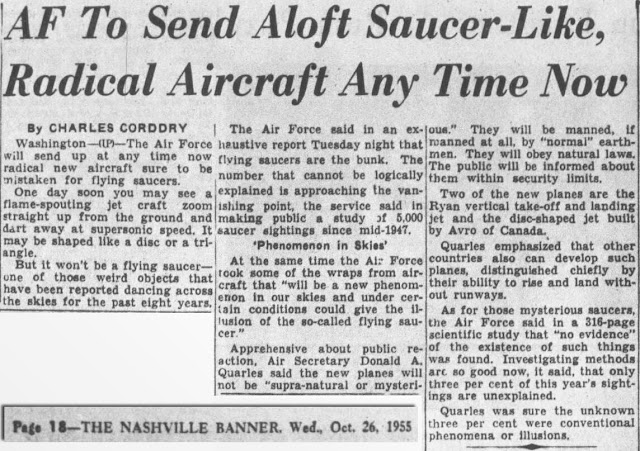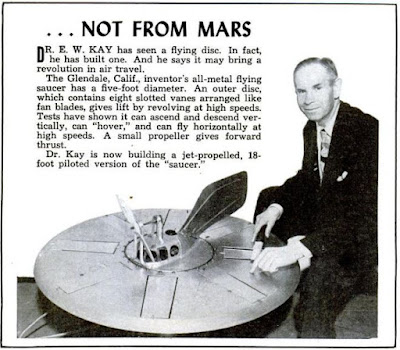It’s not all Donald Keyhoe’s fault. In late 1949 “The Flying Saucers are Real” was published in True magazine, Jan. 1950, causing the topic of UFOs to be taken more seriously. There was no proof that the sightings and reports of these UFOs represented physical objects. With all the talk, many people came to believe in saucers, but couldn’t agree what they were, or where they came from. The notion that saucers came from space was catching on, but most people believed that if saucers were real, they were made on earth – probably by the USA.
 |
| David Lawrence, publisher of U.S. News & World Report |
April 3, 1950 – Conservative newsman David Lawrence shocked readers by publishing, “Flying Saucers: The Real Story,” in U.S. News & World Report, April 7, 1950. He reported that saucers were not only real, but U.S. military aircraft: “Jet-propelled disks can outfly other planes... about the only big secret left is who makes them. Evidence points to Navy experiments.”
 |
| “Flying Saucers: The Real Story,” U.S. News and World Report, April 7, 1950 |
The notion gained found support. Henry J. Taylor was a major newspaper and radio commentator, and (without referencing Lawrence’s article) he also made the amazing announcement that flying saucers are real - and were US military secret projects.
The editorial, “Flying Saucers,” in The Fort Collins Coloradoan, April 11, 1950, discussed Lawrence’s article and talked about distrust, “Blanket Denials… from Washington are common… The fact that the President or one of his lieutenants says something isn't so doesn't mean a thing any more.”
"I am now allowed to tell you that some flying saucers are real. They belong to our Air Force. They will someday be a big help to our country."
People Today magazine, Sept. 10, 1952, said, “Flying Saucers are Real – Remember the A-Bomb.” The key source for the article was Dr. Lincoln LaPaz, head of the Institute of Meteoritics at the University of New Mexico. “Sightings here and in Scandinavia lead me to believe that fireballs and the so-called saucers may be guided missiles – some possibly ours, some possibly Russian. In any case, they are Earth-born.”
Air Force Saucers
In the United Press article by Charles Corddry in The Nashville Banner, Oct. 26, 1955, Air Force Secretary Donald A. Quarles was quoted on new aircraft in development that "will be a new phenomenon in our skies and under certain conditions could give the illusion of the so-called flying saucer." He was referring to the vertical take-off and landing jets and the disc-shaped jet being developed by Avro of Canada, but the minds of some readers jumped to the conclusion that this was an Air Force cover story. One camp thought this was admission the saucers were military all along, another was that it was to distract from the real, alien flying saucers.
 |
| St. Louis Post-Dispatch, Oct 26, 1955, AP |
Russian Saucers
On Oct. 2, 1957, news agencies INS and UP reported that Professor S. Zonshtein said that Russia had a disc-shaped plane that could “rise and descend vertically.”
Brigadier General Frank H. Britton, Director of Developments, Office of Chief of Research and Developments, U.S. Army. Gave testimony on the Avro project before the House of Representatives, Committee on Science and Astronautics, Washington, DC, April 13, 1959.
The Associated Press reported on the testimony, stating:
“The secrecy curtain was withdrawn slightly Thursday night from a hush-hush project which the Army hopes will give the United States its version of the flying saucer. Heavily censored testimony made public by the House Space Committee confirmed that the revolutionary new aircraft will resemble a saucer.”
Meanwhile, the US Army was using flying saucers as bait to entice soldiers to reenlist. The image below was used both as a poster and in print ads.
Space Age
Since 1950, the public had been told flying saucers were real, and that they might be made in the USA. In 1960, a flying saucer was curiously among the rockets and satellites depicted in the poster by Richard Amundsen, “Space Age” from Educational Posters Co.
The idea was reinforced when New York Mirror magazine, April 28, 1963 used illustration for the article, “U.S. Space Hardware - Today and Tomorrow.”
Having a flying saucer depicted among other spacecraft projects blurred the line between fact and fantasy. But it wasn’t just any saucer, it was drawn from the cover of Keyhoe’s 1950 book.
Mixed Messages
Since 1947 the Air Force had denied flying saucers were real. They muddied the waters in 1955 by saying they were building saucer-like craft. That encouraged the belief in physical flying saucers from earth – or elsewhere. The original Avro project failed, but it eventually did produce a marginal flying saucer for the U.S. Army, the Avrocar, which was a disc-shaped hovercraft. Two vehicles were built and tested, then the project was cancelled in 1969. So was Project Blue Book. The U.S. government just wanted to forget the whole saucer business for good.
. . .
See our previous articles on the many Man-Made Flying Saucers.
For more on the Avro saucer story, see the section, “The US Preparations for Man-made Saucer” of UFO Study Programs and US Military Technology.












.jpg)


































.png)



